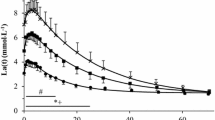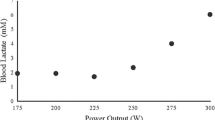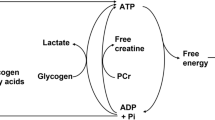Summary
Arterial blood lactate concentrations were measured in six normal males before, during and after 3 and 6-min bicycle exercises performed at three different work rates. The lactate recovery curves were fitted to a bi-exponential time function consisting of a rapidly increasing and a slowly decreasing component, which supplied an accurate representation of the changes in lactate concentration. Variations in the parameters of this mathematical model have been studied as a function of the duration of exercise and of the work rate, showing a clear dependence on exercise duration such that increasing exercise length decreases the velocity constants of the fitted curves. In terms of the functional meaning which can be given to these constants, this result indicates that extending exercise duration from 3 to 6 min reduces the ability of the whole body to exchange and remove lactate. This effect did not qualitatively modify the one already described, which is due to increased work rates, but it shifted the ability to exchange and remove lactate towards lower values. The main conclusion of the study is that lactate kinetic data vary as a function of time during exercise. This inference must be accounted for in the interpretation of lactate data obtained during muscular exercise.
Similar content being viewed by others
References
Ahlborg G, Hagenfeldt L, Wahren J (1976) Influence of lactate infusion on glucose and FFA metabolism in man. Scand J Clin Lab Invest 36:193–201
Bang O (1936) The lactate content of the blood during and after muscular exercise in man. Scand Arch Physiol [Suppl] 10:51–82
Bonen A, Campbell CJ, Kirby RL, Belcastro AN (1978) Relationship between slow-twitch muscle fibres and lactic acid removal. Can J Appl Sport Sci 3:160–162
Depocas F, Minaire Y, Chatonnet J (1969) Rates of formation and oxidation of lactic acid in dogs at rest and during moderate exercise. Can J Physiol Pharmacol 47:603–610
Donovan CM, Brooks GA (1983) Endurance training affects lactate clearance, not lactate production. Am J Physiol 244 (Endocrinol Metab 7):E83-E92
Eldridge FL (1975) Relationship between turnover and blood concentration of lactate in exercising dogs. J Appl Physiol 39:231–234
Freund H (1967) Dosage automatique continu de l'acide pyruvique. Description de la méthode et application aux dosages simultanés de la pyruvicémie, de la lactacidémie et de la glycémie. Ann Biol Clin (Paris) 25:421–437
Freund H, Zouloumian P (1981a) Lactate after exercise in man. I. Evolution kinetics in arterial blood. Eur J Appl Physiol 46:121–133
Freund H, Zouloumian P (1981b) Lactate after exercise in man. IV. Physiological observations and model predictions. Eur J Appl Physiol 46:161–176
Freund H, Jacquot P, Marbach G, Pellier A, Ramboarina D, Vogt JJ (1970) In vivo physiological experiments on the Autoanalyzer in a computerized environment. In: Advances in automated analysis, vol. 1. Mediad, White Plains, NY, pp 195–198
Freund H, Oyono-Enguelle S, Heitz A, Marbach J, Ott C, Zouloumian P, Lampert E (1986) Work rate dependent lactate kinetics after exercise in humans. J Appl Physiol 61:932–939
Hermansen L, Osnes JB (1972) Blood and muscle pH after maximal exercise in man. J Appl Physiol 32:304–308
Hirche H, Hombach V, Langhor HD, Wacker U, Busse J (1975) Lactic acid permeation rate in working gastrocnemii of dogs during metabolic alkalosis and acidosis. Pflügers Arch 356:209–222
Iles RA, Cohen RD, Rist AH, Baron PG (1977) The mechanism of inhibition by acidosis of gluconeogenesis from lactate in rat liver. Biochem J 164:185–191
Issekutz B Jr, Shaw WAS, Iseekutz AC (1976) Lactate metabolism in resting and exercising dogs. J Appl Physiol 40:312–319
Jorfeldt L, Juhlin-Dannfelt A, Karlsson J (1978) Lactate release in relation to tissue lactate in human skeletal muscle during exercise. J Appl Physiol Respir Environ Exerc Physiol 44:350–352
Kreisberg RA, Pennington LF, Bashell CP (1970) Lactate turnover and gluconeogenesis in normal and obese humans. Effects of starvation. Diabetes 19:53–63
Mainwood GW, Worsley-Brown P (1975) The effect of extracellular pH and buffer concentration on the efflux of lactate from frog sartorius muscle. J Physiol 250:1–22
Mazzeo RS, Brooks GA, Schoeller DA, Budinger TF (1986) Disposal of blood (1–13C) lactate in humans during rest and exercise. J Appl Physiol Respir Environ Exerc Physiol 60:232–241
Sahlin K (1978) Intracellular pH and energy metabolism in skeletal muscle of man with special reference to exercise. Acta Physiol Scand [Suppl] 455:3–56
Sahlin K (1986) Muscle fatigue and lactic acid accumulation. Acta Physiol Scand [Suppl] 556:83–91
Searle GL, Cavalieri RR (1972) Determination of lactate kinetics in the human analysis of data from a single injection versus continuous infusion methods. Proc Soc Exp Biol Med 139:1002–1006
Sejersted OM, Vollestad NK, Medbø JI (1986) Muscle fatigue and electrolyte balances during and following exercise. Acta Physiol Scand [Suppl] 556:119–127
Simon J, Young JL, Blood DK, Segal KR, Case RB, Gutin B (1986) Plasma lactate and ventilation thresholds in trained and untrained cyclists. J Appl Physiol 60:777–781
Stanley WG, Gertz EW, Wisneski JA, Morris DL, Neese RA, Brooks GA (1985) Systemic lactate kinetics during graded exercise in man. Am J Physiol 249 (Endocrinol Metab 12):E595-E602
Steinhagen C, Hirche H, Nestle HW, Bovenkamp U, Hosselman I (1976) The interstitial pH of the working gastrocnemius muscle of the dog. Pflügers Arch 367:151–156
Tesch P, Sjödin B, Thorstensson A, Karlsson J (1978) Muscle fatigue and its relation to lactate accumulation and LDH activity. Acta Physiol Scand 103:413–420
Tesch P, Sharp DS, Daniels WL 1981) Influence of fiber type composition and capillary density on onset of blood lactate accumulation. Int J Sports Med 2:252–255
Woll PJ, Record CO (1979) Lactate elimination in man: effects of lactate concentration and hepatic dysfunction. Eur J Clin Invest 9:397–404
Zouloumian P, Freund H (1981a) Lactate after exercise in man. II. Mathematical model. Eur J Appl Physiol 46:135–147
Zouloumian P, Freund H (1981b) Lactate after exercise in man. III. Properties of the compartment model. Eur J Appl Physiol 46:149–160
Author information
Authors and Affiliations
Rights and permissions
About this article
Cite this article
Freund, H., Oyono-Enguelle, S., Heitz, A. et al. Effect of exercise duration on lactate kinetics after short muscular exercise. Europ. J. Appl. Physiol. 58, 534–542 (1989). https://doi.org/10.1007/BF02330709
Accepted:
Issue Date:
DOI: https://doi.org/10.1007/BF02330709




